
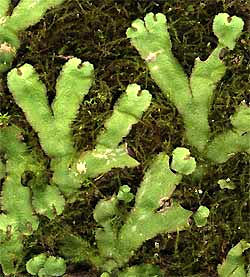
One reason liverworts are fun to know is that in terms of the evolution of life on Earth, these plants are primitive. Seeing them is almost like looking back in time.
In 2018, Jennifer Morris and others published The timescale of early land plant evolution, concluding that land plants emerged around 500 million years ago. Recent studies indicate that the first land plant may have looked rather like a liverwort, and was a close ancestor to liverworts, but itself was not quite what we call a liverwort. It's still not known what the first kind of land plant was, but liverworts certainly arose very soon after both animal and plant life moved onto land.
WHAT MAKES A LIVERWORT A LIVERWORT?
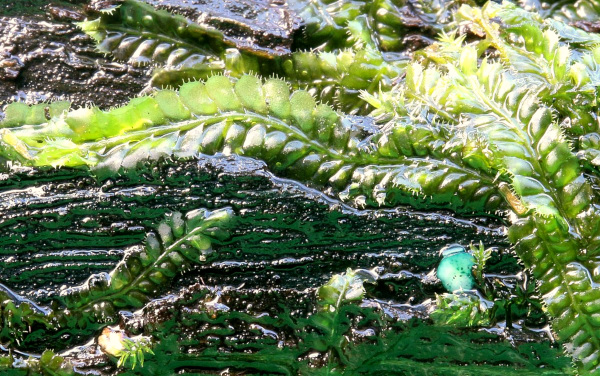 Heteroscyphus liverwort in Australia; courtesy of Peter Woodard, via Wikimedia Commons
Heteroscyphus liverwort in Australia; courtesy of Peter Woodard, via Wikimedia CommonsReflecting their primitive nature, liverwort bodies are the simplest of all green plants. They have no vascular system, so must rely on diffusion for moving water and photosynthesized carbohydrates within themselves. Instead of true roots -- true roots defined as having a primary root with secondary branches -- liverworts have root-like single-celled rhizoids. Accepting that a leaf must have a vascular system, neither mosses nor liverworts bear true leaves, though they may have leaf-like appendages sometimes referred to as leaves, but more technically called phyllodes.
Liverworts and mosses probably arose from a common ancestor, so they're very similar. However, while moss phyllodes often have ribs, or "costa," running down their lengths, liverwort phyllodes have no costa. Similarly, moss phyllodes bear openings called stomata, where gas exchange takes place, but liverwort phyllodes have no stomata.
TWO MAIN KINDS OF LIVERWORTS
The 9,000 or so species of the Earth's liverworts often are divided into two groups -- the thallose and the leafy liverworts.
The image atop this page shows a thallose liverwort ( ).
).
The next picture below that is of the leafy kind ( ).
).
It's awkward to make the point that, technically, liverworts bear no leaves, but rather some of them produce phyllodes, and then speak of the leafy liverworts. However, that's what happens when traditional terminology lags behind what's understood.
ASEXUAL REPRODUCTION
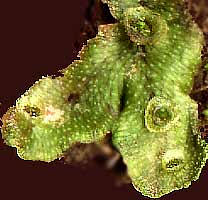
Sometimes you're lucky enough to see what's shown at the right. The bowl-like items are gemma cups, and the tiny, egg-like things are gemmae.
Gemmae are simply tiny pieces of the liverwort body, or thallus, which are easy to dislodge. When raindrops fall into the gemma cups, gemmae are splashed from the cup, and possibly carried a fair distance in running water. New liverworts grow from the gemmae, thus forming new plants with no sex involved
SEXUAL REPRODUCTION
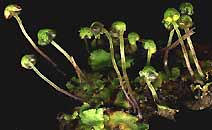
Finding liverworts during the sexual part of their life cycle is just as exciting as finding them with gemma cups. At certain times liverworts develop little umbrella-like structures at the edges of their thalli, called receptacles or, technically, gametangiophores. At the left, female receptacles are shown on a thallose liverwort.
About 80% of liverwort species have male and female receptacles on separate plants (the plants are dioecious), while the other 20% produce male and female receptacles on the same thallus (the plants are monoecious). Male receptacles also are called antheridial receptacles or antheridiophores, and female receptacles can be called archegonial receptacles or archegoniophores. You might guess that when a male plant's sperm reach a female plant's eggs, a zygote is formed, and then an embryo.
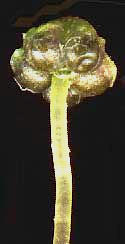
The embryo then develops into a capsule filled with spores. At the right you see a much-magnified view of an archegonial receptacle from below, showing several spherical capsules filled with brown spores. As among mosses, soon the capsules will rupture and spores will be released. If a spore happens to land where environmental conditions are just right for it, then the spore will germinate into a liverwort.
OTHER STUFF
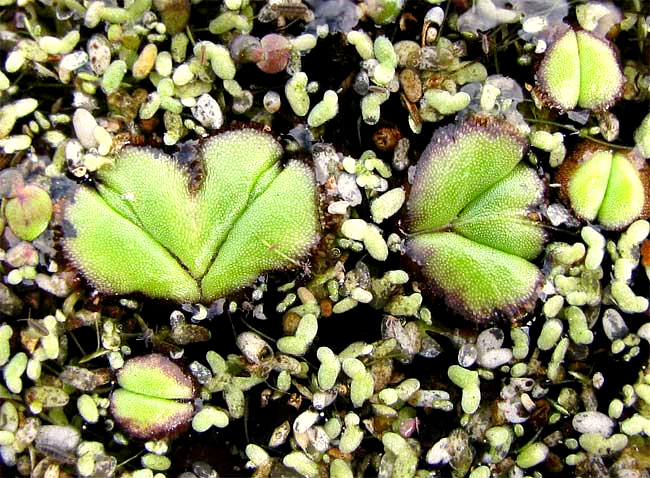
A number of thallose liverwort species are aquatic -- they grow on the water's surface like flecks of lettuce. At the left, the smaller bodies floating atop water in a ditch in Mississippi are those of duckweed, Lemna minor, a flowering plant. The larger bodies with purplish margins are Purple-fringed Riccia, Ricciocarpus natans, an aquatic liverwort.
You may be remembering that liverwort thalli bear no veins or midribs, though these liverwort thalli seem to have something like branching veins. Each liverwort-thing is two or more liverworts. The vein-like structures are separation lines between thalli with no veins.
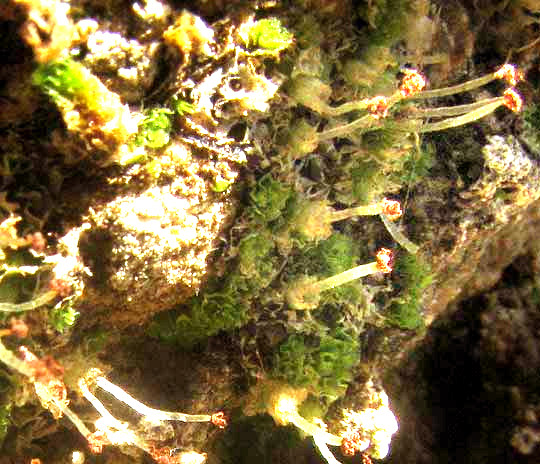
The green, ribbon-like liverwort atop this page displays the most commonly encountered and recognized liverwort type. The number of species of leafy liverworts may be greater than the ribbon type, but they're less noticed. Other forms exist and are worth looking for. For example, at the right is the rarely documented Texas Fossombronia, Fossombronia texana, growing among wet, marl-covered boulders in a south-Texas stream, producing some kind of stalked receptacle. Technically this species is considered a thallose lichen, but the thallus is ruffled, looking leafy. Sometimes the backyard naturalist just has to read what the experts say, because in the field often it's impossible to interpret these details.
Liverworts are called liverworts because long ago the people who named them felt that the curious arrangement of cells on the surface of some liverworts was similar to the cell arrangement in actual livers taken from animals.
On the Web, check out these sites: